"JULLEY" is how one greets another in Ladakh (“land of high passes”) a remote region in the north-western Trans- Himalayas which until recently was within the state of Jammu and Kashmir and is now administered by India as an union territory.
Geographically located along the Great Himalayas and the Karakoram ranges, also a region that is sparsely inhabited by people, who are of the Indo- Aryan and Tibetan race.
It’s the western most extension of the Tibetan plateau placed at an altitude that ranges from 2000 meters to 7650 meters above sea level.
Had been to some regions exactly ten years back (click to read the trip report of the previous trip) though that trip was primarily for leisure, but had done some birding, relatively this trip was primarily planned only for birding!
We landed in Central Ladakh, Leh (3550 m) in the early hours directly from Mumbai airport, must say not only did the temperature drop drastically, even the network signals seemed to have dropped to a level, that it did not come till we flew back to Mumbai. (Note: One must carry either a BSNL or JIO connection, that also only postpaid to get some connectivity)
Today the day one (June 2nd), was to take rest and acclimatise to the low oxygen levels. In the evening we strolled around the beautiful town of Leh, that had a vibrant market, well paved pathways. Being the first week of June, the well clad tourists had already arrived and the place was surely buzzing. The weather was cool (around 14 deg C)
Shey marshes (3550m):
Day two, we planned a trip to Shey marshes that are located in the outskirts of Leh town, at a distance of 7 kms, the birding area across this irrigation channel after crossing the river was surprisingly almost dry at this time of the year too. But inspite of being dry, the region offered some great birding, birds that we could see here were Hume’s lesser White-throat, Eurasian Hobby, Citrine Wagtail, Carrion Crow to name a few.
 |
| Mountain Chiffchaff |
 |
| Carrion Crow |
There were sighting reported of the Mongolian Finch by the local birders from the Thiksey region and we drove there, while we were scanning the area, saw two of them fly over us and they went and perched far away on the barren ridges. Rajesh ji took a long stroll looking for them, while we waited and scanned for other birds along the flowing river, but there was no sign of them.
Sindhu Ghat and Spituk (3550m):
Sindhu Ghat and Spituk are both areas again within a radius of 10 kms from Leh, along the upstream Indus (Sindhu) River. Along one of the most peaceful river banks, we sighted a pair of Ibisbill, the calls of Mountain Chiffchaff were the most common and their calls echoed in the wind.
In Sanskrit (ancient language), Sindhu denotes a ‘large water body’ and this river is one of the most important rivers in the history of India. Not only India gets its name from this river, the people residing in this country are proudly known as Hindus.
We did visit the area where the Lesser Grey Shrike was seen a few days back, we did see the Long-tailed Shrike instead, along with a couple of Mallard, Common Rosefinch and some commoners.
As we kept walking looking for the birds, realised that we were not going out of breath, a sort of a confirmation that the acclimatisation had begun. As the day two came to an end, we had our inline permits for our onward destinations ready. Our typical birding routine was to begin from tomorrow, that is rising along with the sun and look for birds till sun down. Here in Ladakh birding in the night was not allowed, typically to ensure that no wildlife is disturbed.
Nubra Valley:
Day three we headed towards the Nubra valley, which is famous for its proximity to the Siachen Glacier, the longest glacier in the Karakoram Range. The valley is located to the North of Leh and was off-limits to travelers until 1994, it can now be approached by crossing the famous Khardung La Pass (5700m), a one time the highest motorable road in the world, until newer passes were made. Prior to reaching the pass, we stopped at South Pullu, here we sighted a pair of Brown Accentors and a lone Black-winged Snowfinch. As we had reached the pass very early in the morning, due to which there were very few tourists, the Yellow-billed Chough were seen feeding outside the restaurant.
 |
| Brown Accentor |
We had a long way to cover so quickly moved down towards North Pullu, another reason for not spending more time at the Khardung La was to avoid altitude sickness, the oxygen levels can get very low due to the air being much thinner at these altitudes. Just after ascending into North Pullu, we sighted the Robin Accentor busy collecting nesting material. There are very little places where one can find a flowing stream and green pasture here, finding one ensured we sight some birds too, like the Hill Pigeon who had come to quench its thirst in this biting cold weather (early morning's the temperature falls to close to zero here)
 |
| Black-winged Snowfinch |
As we drove further towards Nubra valley, took a brief halt at Khalsar (3260m). Apart the commoner Mountain Chiffchaff and the Eurasian Magpie, we sighted the White-browed Tit-Warbler (male) that was busy feeding. Soon we headed out further crossing the town of Diskit towards Turtuk.
Turtuk (2820m) is the small hamlet that sits at the far end of Nubra Valley, hemmed in by the Shyok River and the high peaks of the Karakoram mountain range. Surrounded by crumbling rock faces, this is the only place where one can stay before visiting Thang, India's northern-most village beyond the LAC on Indo-Pak border. Turtuk's rather has a tumultuous history, as it's a village that was claimed back from the region of Gilgit-Balistan.
Came across a gentleman (Mohd Ibrahim) who kept smiling and approached us, to share that he was born in 1958 and until 1971 was a citizen of Pakistan, now an Indian. Most of Ladakh has a strong Buddhist and Tibetan influence, however this region has a distinct Balti Muslim culture.
We had traveled this distance to look for the Pied Wheatear that was seen around this time of the year. An isolated gorge, the region was the lowest in terms of altitude and bird count too, we did sight the Bluethroat, Chukar and few other commoners.
 |
| Bluethroat |
After having a good breakfast in this beautiful but remote location on day four, started to head towards Hunder village that sits like an oasis in the middle of cold desert in Nubra valley a couple of kms from Diskit town, which is known for its Buddhist monastery.
 |
| Diskit Gompa |
Nubra valley has also acquired fame for its sand dunes. Most tourists come here to ride on the Bactrian camels and enjoy its breath-taking natural beauty. The high altitude desert offers not only a rolling expanse of sand dunes and barren landscape but also offers a chance to see rare birds like the Pale Rosefinch, that can be seen during this time of the year. We had to keep looking out of the window if we can see any movement, along this 70 odd kms stretch. There were couple of instances, when we stopped enroute and were lucky to see the Sulphur-bellied Warbler, Hume's Lark and a flock of Mongolian Finch before reaching the town of Agham.
 |
| Mongolian Finch |
 |
| Sulphur-bellied Warbler |
Agham (3285m):
Agham was the place where we stayed on the fifth day. Here we got some good sighting of the White-browed Tit-Warbler who were busy nesting. As we drove towards the neighbouring region, sighted a Golden Eagle sitting on its nest, that was made along the slope of a tall mountain. Just along another village came across a small flock of the Eurasian Skylark feeding in the fields, we then drove along a stretch of stream, here we sighted the White-throated Dipper (brown morph), Lammergeier soaring high and a wallcreeper along with many Hill Pigeons who were busy feeding along the slopes of these mountains.
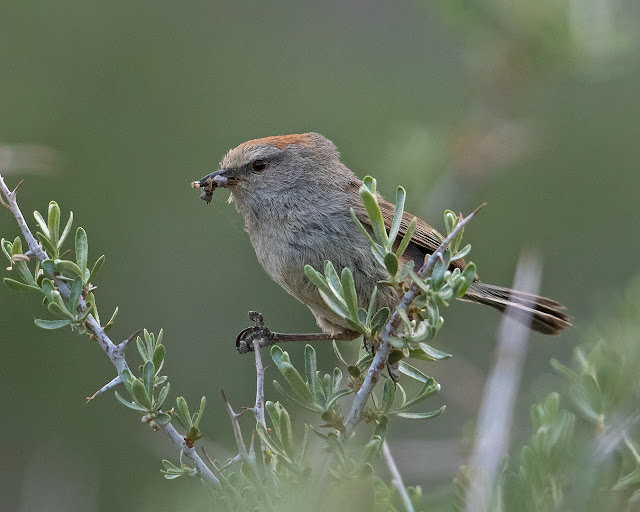 |
| White-browed Tit-Warbler |
 |
| Golden Eagle |
 |
| Eurasian Skylark |
The Himalayan Marmot called "Phia" in ladakhi were seen often, most of them were basking on the boulders as they hibernate for almost six months of a year in burrows. Once they are out some young ones are in a very playful mood, but no sooner they spot us, will simply pretend nothing is happening and rush to get into their burrows.
 |
| Himalayan Marmot |
As we were heading out of this town towards Wari La, which is a high mountain pass, sighted a whole herd of Blue Sheep that were probably grazing on the other side of the river and soon after seeing us, moved swiftly over the mountain. They can climb up high and inaccessible cliffs like a goat. They are called "Napo" in Ladakhi, they have a slate blue coat which turns reddish brown during the warmer months.
 |
| Blue Sheep |
Wari La (5300m):
Enroute from Agham to Wari La, there were plenty of steep sections on this route. Surely the road would be impassable in winters, as even in the month of June we saw heavy snow on some sections of this road. Very few tourist vehicles use this road. The zigzags on the south side of the pass were losing height tortuously slowly.
There were no signboards along the road, there were none even on the pass, only prayer flags marked this pass. The climb was simply tough, with a notorious lack of oxygen and a high degree of steepness. We were feeling fine, so we stopped on the pass to look for the two species of Snowcock that are found here, unfortunately there were none that day.
It was very windy and cold, so we were soon drove over the pass and moved towards our stay for the night. Enroute, along a long stretch of winding road that was going downhill, sighted the the Woolly Hare also known as "Ribong" in Ladakhi. It swiftly started to sprint on seeing us and settled under a large boulder, it had a thick and curly fur with a bushy tail, long hind legs and black tipped ears.
 |
| Woolly Hare |
Chang La (5390m):
Day six, we set out towards Pangong Tso, by crossing over another high pass, called the Chang La pass. Just about some distance before the pass we heard the calls of the Tibetan Snowcock, to our delight we also sighted the Himalayan Snowcock. There was a flock of 5-6 of each of the species, that had flown in from one end to settle down between the large boulders, and only occasionally when they would cross could see them. Compared to the two, the Himalayan surely seemed more shy and kept its distance from us.
It was just the time the sun had risen, the traffic was building up and lots of vehicles where moving towards the famous high altitude lake.
 |
| Himalayan Snowcock |
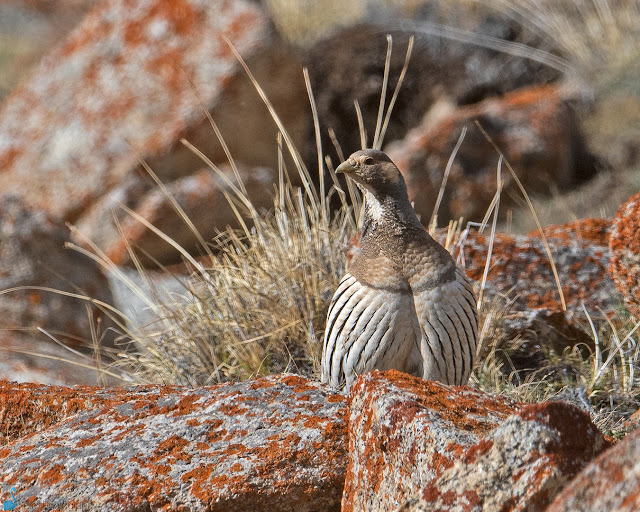 |
| Tibetan Snowcock |
 |
| Tibetan Snowcock |
We had hardly driven a little and just as we were to approach the pass, sighted a lone Alpine Accentor. Rajesh heard the call of the Red-fronted Rosefinch, who later obliged us with some amazing poses amidst its feeding ritual.
 |
| Red-fronted Rosefinch |
On reaching the top of the pass, we stopped by the restaurant to have breakfast. Today preferred to have a hot bowl of Thukpa (a local dish). The wind was gushing into the restaurant every time someone opened the door. Many bikers and tourists had stopped by posing for photographs.
As was leaving felt the head was getting a little heavy, probably due to the time we had spent at the altitude. We descended the pass, the landscapes began to change again, soon we reached a spot where the beauty of the green fields were unmatched. It was a delight to see such light green fields after watching the browns in different shades all along.
Its usually the breeding time for birds during this time of the year here. We sighted a pair of White-throated Dipper that was flying over the stream at high speed in a zig zag flight pattern, here we sighted a juvenile too.
 |
| White-throated Dipper |
Pangong Tso (4225m):
One third of this long (135km) lake is in India and rest is in China. During peak winters (mid-January to February end), Pangong Tso completely freezes and they say its hard enough for cars to drive on! (though no one drives - hopefully)
The lake displayed a range of colours as the sunlight fell over the water, blue to cobalt and some shades which are difficult to even name.
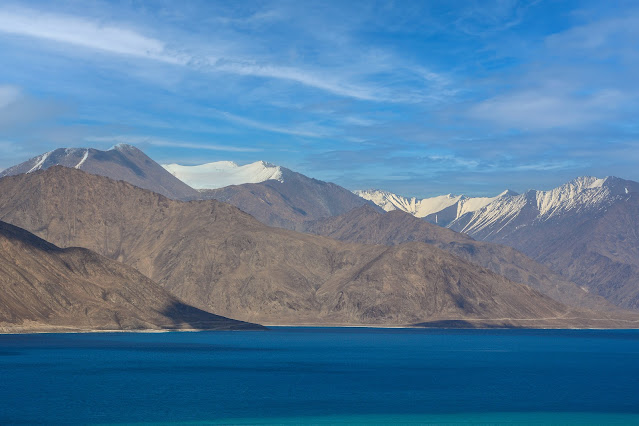 |
| Pangong Tso |
Glad we were here in the summer, the streams en route, looked picturesque, after making a brief stop here, we drove for another 35-40 kms along the lake, till we slowly descended and reached Merak Village, a place where we were to stay for the night. Staying overnight at a little lower altitude is advisable. On reaching here decided to rest for a while to recover from the altitude sickness. Had been practicing the "Yog" taught my our spiritual master which surely helped me recover faster.
Merak Village (3550m):
We woke up early on day seven as well, the lake looked very ordinary and dull, simply because the sunlight was missing. The breeze was very cool and the birds were all over the fields in this village, which is located on a narrow stretch of land between the mountains and the lake, with just half a dozen families that make a living by rearing pashmina goats and growing barley during the short summer season.
After birding for a couple of hours, drove towards Chushul village and enroute sighted the Tibetan Wild Ass, Mountain Weasel, Tibetan Partridge and many birds.
From Chushul we were to proceed to Hanle. Since Pangong Tso is on the LAC, NRIs and Foreigners need Protected Area Permit in order to visit the area.
 |
| Chinese Rubythroat |
 |
| Horned Lark |
We just needed to submit a form at check posts that was already obtained in Leh. Rajesh ji shared a lot of interesting stories and one of them was related to the Chushul war, wherein our brave soldiers lost their lives and to mark their bravery, the Chushul and Rezang La War Memorials were built.
Once we reached Chumathang, were overwhelmed by seeing many herds of the Tibetan Wild Ass, grazing peacefully on the grasslands. The landscape changes in split second, with many colours being induced into the mountains due to the various deposits.
But much before we reached Chumathang, had to drive through open barren stretches. Only an experienced driver can find the way to reach Mahe, a junction to Hanle and TsoMoriri. Rigzin mentioned that if at it rains, it makes it even more difficult to find the way. Mostly could only see army vehicles use this stretch. The bird activity was low in this patch.
In fact, all the way to Loma and up till the village of Nyoma, the bird activity was relatively very low. Once a while we could see the Black Redstart and the Desert Wheatear, that would catch our attention.
Hanle Plains and Marshes (4350m):
As we were approaching Hanle, could only see a monastery built on a hilltop with no sign of any village. Even after the checkpost, there was no sign of any village. But after a few kms we reached a suburb very close to the Solar observatory, which was our stay for the night.
We did come across many bikers that had come to Hanle, as its also the base and gateway to a couple of high altitude passes like Photi La and the recently glamoured highest pass of the world, Umling La. Inspite of a number of home-stay options available here in Hanle, it seemed many (specially bikers) come here unplanned and try to look for a stay. One must also carry enough fuel for this trip as there are no petrol pumps (fuel stations) once you leave a small town about 60-70 kms after Leh for your entire journey.
The entire village was small and cozy and way far from any disturbances and surely would provide ample opportunities to stargazers and astro photographers. Though we were to stay here for day eight and and day nine, did not consider this option, simply because we had to get up early the next day too.
The following morning we headed towards the plateau, hardly a few minutes after sunrise sighted the den of the Himalayan Red Fox on the hill side, it was a family of four cubs and the female was guarding them closely, we kept our distance and enjoyed watching them play in the early morning light.
 |
| Himalayan Red Fox |
We continued to drive and along another hill side and sighted the Eurasian Eagle-Owl, there were two of them perched quite high in the crevices, maybe one of reasons they were unaffected of our presence. We also saw an abandoned nest of the Upland Buzzard.
Many birds were sighted here, that were common to the region like the Great Rosefinch, Tibetan Lark to name a few. The area is very vast, hence the density may seem low (in term of the bird count)
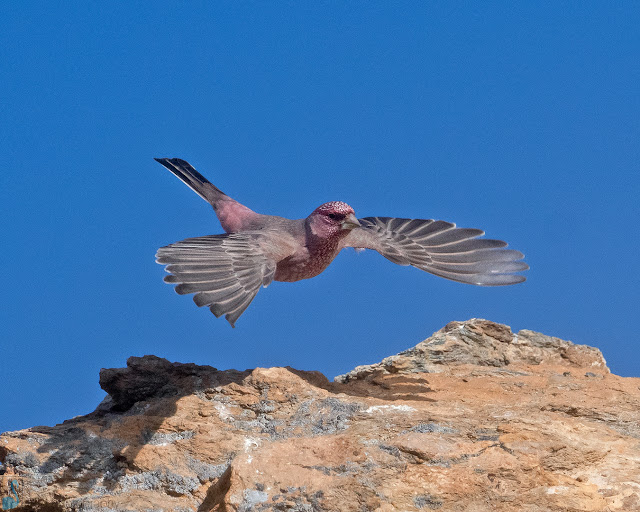 |
| Great Rosefinch |
 |
| Tibetan Lark |
As we drove spotted a pack of Tibetan Grey Wolf (around 6-7), no sooner we saw them they all started to move away from us and there was an instance, when they were peeping from a level lower than ours to see our movement. Just took a few long shots and we decided to drive on.
 |
| Tibetan Wolf |
Over the next two days we sighted the mighty Upland Buzzard and the endangered Saker Falcon, which had perched itself on an electric pole (as there are no trees) and looked fabulous with the snow clad mountains in the background.
 |
| Saker Falcon |
There was an instance when a Tibetan Wild Ass decided to take a dust bath and on another instance, we saw a whirlwind which did not seem to bother another pair of Tibetan Wild Ass
 |
| Tibetan Wild Ass |
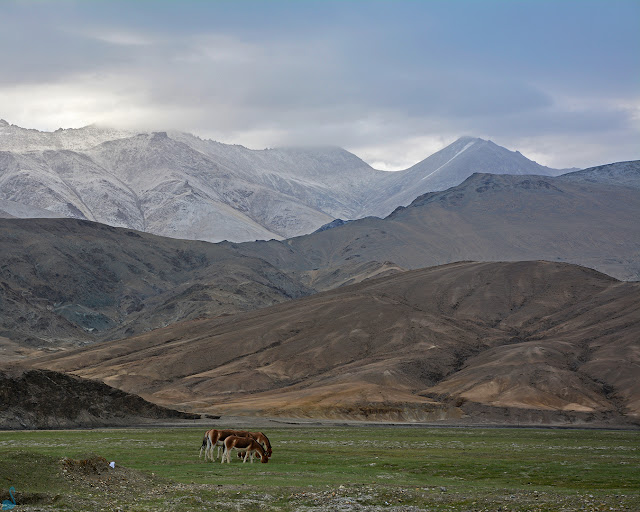 |
| Tibetan Wild Ass |
Tsomoriri Lake (4595m):
Day ten, we set out after taking a short drive in the Tibetan plateau towards Tso Moriri, the largest of the high altitude fresh water blackish lakes in the nation. It’s a protected area officially known as "Tso Moriri Wetland Conservation Reserve"
Before we could reach Tso Moriri, that is best known as breeding ground for the Black-necked Crane and the Bar-headed Geese, stopped enroute before Mahe bridge, here we sighted a pair of Black necked cranes with two chicks, they were so tiny that they could hardly walk, but surprisingly could swim well. We noticed that they only communicated and (maybe) directed the chick to climb the mount, but did not pick it up and placed it on the mound, as a mammal would do. After breeding, the chick needs to get ready to fly back to its wintering ground from its breeding ground.
Just as we were nearing the lake, sighted the Little Owl, again perched
on a electric pole. No matter how we approached it, it felt safe and did
not move.
.jpg) |
| Black-necked Crane |
 |
| Little Owl |
The place was indeed cooler than all the other places we had been till now, in the evening we moved up to the valley, but surprisingly the bird activity was very low, just the very common species were seen. The place also had a lot of tourists and could see many tented accommodations that were available for the bikers and 4x4 enthusiasts. The Red-billed Chough and the Yellow-billed Chough were seen in large numbers, specially on the roof tops of the hotel and the monastery.
As there was hardly any bird activity and mostly the species we had seen were to be seen, retired early and had already decided to move towards Tsokar directly in the wee hours.
 |
| White-throated Dipper |
Tsokar Lake (4530m):
Day ten, and we were traveling towards Tsokar which is a high-altitude wetland. As we were approaching the region, first came across Startsapuk Tso, a freshwater lake unlike Tso kar which is a hyper saline lake. The lake looked white because of the white salt efflorescence found on the margins due to the evaporation of highly saline water, the very reason for Tso Kar to get its name (literally meaning white lake)
The Tibetan Wild Ass were seen grazing on the pastures on the side of the lake. Tso Kar is breeding ground for Bar-headed Goose & Ruddy Shelduck and we did see a few of them along the edges. A pair of juvenile Black-necked cranes was seen too. There was a lot of construction being carried out, newer resorts, better infrastructure being planned. All these factors had resulted in fewer birds, specially the Little Owl was not being seen in the area.
We visited a location where the nomads come to spend their winters, their houses were built of stone and a lots of droppings of the cattle was all over the floor. Presently, it was abandoned, many birds had found their safe haven here and were see feeding on the insects that come on the droppings.
 |
| Blanford's Snowfinch |
Though Tso Kar Basin is an A1 Category Important Bird Area (IBA) as per Bird Life International and a key staging site in the Central Asian Flyway, decided to drive around the lake from one end to the other, we drove along the tracks that already existed, crossing the land which seemed to hard for anything to survive.
However the birds come here in all seasons, we sighted the Upland Buzzard, a herd of Tibetan Argali feeding at a distant slope, they suddenly started to run for reasons better known to them, as they were far away took some footage (video) as well of them galloping away. Its only moments later we saw a Himalayan Red Fox reach the same spot (maybe the reason why the Argali galloped away)
 |
| Upland Buzzard |
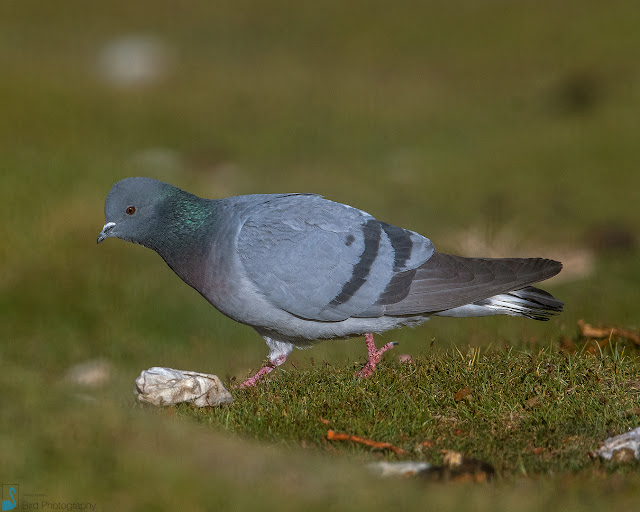 |
| Hill Pigeon |
 |
| Ground Tit |
With very little rain the Himalayan chains are generally dry and cold, the adjoining Central Ladakh is dominated by two important ranges in the Southern Zanskar range and the Ladakh range which is almost parallel to the Nubra Valley. Most of Ladakh has been a dry cold desert. But when we went there this time noticed a lot of greenery. The poplar and willow trees given by Defence Institute of High Altitude Research (DIHAR) are growing very well.
Day eleven (12th June), it was a day when the trip was on its last leg, we were to head out from Tsokar Lake towards Tanglang La Pass yet another incredible high altitude mountain pass in Ladakh located on Manali - Leh highway. We were excited as we had chances of sighting the Blyth's Rosefinch, as again a team of birders from the Ladakh bird club had reported it from a place near Upshi
We took a stopover on the pass, it had started to snow a little and to add to our luck heard a call of the Tibetan Snowcock, may it was wanting to cross the road and waited at the edge.
We drove a very slow speed before we reached Upshi, scanning very possible location, listening to bird calls that would come, we sighted the commoners but no sign of the bird we wished to see. Finally, we decied to park the vehicle and wait along a stretch that had good vegetation, at a distant Rigzin did spot some activity, they were far away and even with the binoculars wasn't easy to confirm the sighting. Rajesh ji could hear their call and was very sure it was them, but they soon flew off further and we had a tougher time looking for them. Again Rigzin managed to see them feed in a field and could see two male and one female of the Blyth's Rosefinch. What a way it was to close the trip with another lifer!
 |
| Blyth's Rosefinch |
Team:
The trip came to an end with a list of 80 birds (25 lifers) as we reached Leh by the end of day eleven, Rajesh ji Panwar had been an excellent tour leader, who knew the locations where we could possibly find the birds we wanted to see, he also made fabulous arrangements for our stay that was cozy and the food that was delicious all along. Rigzin Nubu on the wheels was very patient and made our toughest roads seem like super smooth. Last but not least would like to thank my fellow birder Subhadeep Ghosh who was instrumental in planning this trip.
The route:
 |
| Extract from Maps |
Sharing the detailed sighting on https://ebird.org/india/tripreport/62946
Have complied some footage (birds, mammals and landscapes) to the video above made during our trip, sincerely thanking each one of you and looking forward to many more trips, as the mountains would never stop calling!
Happy Birding!
|
|
ANSERIFORMES: Anatidae |
|
|
|
1 |
Bar-headed Goose |
Anser indicus |
|
|
2 |
Graylag Goose |
Anser anser |
|
|
3 |
Ruddy Shelduck |
Tadorna ferruginea |
|
|
4 |
Mallard |
Anas platyrhynchos |
|
|
5 |
Red-crested Pochard |
Netta rufina |
|
|
6 |
Common Merganser |
Mergus merganser |
|
|
|
|
|
|
|
|
GALLIFORMES: Phasianidae |
|
|
|
7 |
Tibetan Partridge |
Perdix hodgsoniae |
|
|
8 |
Tibetan Snowcock |
Tetraogallus tibetanus |
|
|
9 |
Himalayan Snowcock |
Tetraogallus himalayensis |
|
|
10 |
Chukar |
Alectoris chukar |
|
|
|
|
|
|
|
|
PODICIPEDIFORMES: Podicipedidae |
|
|
|
11 |
Little Grebe |
Tachybaptus ruficollis |
|
|
12 |
Great Crested Grebe |
Podiceps cristatus |
|
|
|
|
|
|
|
|
COLUMBIFORMES: Columbidae |
|
|
|
13 |
Rock Pigeon |
Columba livia |
|
|
14 |
Hill Pigeon |
Columba rupestris |
|
|
15 |
Oriental Turtle-Dove |
Streptopelia orientalis |
|
|
|
|
|
|
|
|
CUCULIFORMES: Cuculidae |
|
|
|
16 |
Common Cuckoo |
Cuculus canorus |
|
|
|
|
|
|
|
|
CAPRIMULGIFORMES: Apodidae |
|
|
|
17 |
Common Swift |
Apus apus |
|
|
|
|
|
|
|
|
GRUIFORMES: Rallidae |
|
|
|
18 |
Eurasian Coot |
Fulica atra |
|
|
|
|
|
|
|
|
GRUIFORMES: Gruidae |
|
|
|
19 |
Black-necked Crane |
Grus nigricollis |
Near-threatened |
|
|
|
|
|
|
|
CHARADRIIFORMES: Ibidorhynchidae |
|
|
|
20 |
Ibisbill |
Ibidorhyncha struthersii |
|
|
|
|
|
|
|
|
CHARADRIIFORMES: Charadriidae |
|
|
|
21 |
Lesser Sand-Plover |
Charadrius mongolus |
|
|
|
|
|
|
|
|
CHARADRIIFORMES: Scolopacidae |
|
|
|
22 |
Common Redshank |
Tringa totanus |
|
|
|
|
|
|
|
|
CHARADRIIFORMES: Laridae |
|
|
|
23 |
Brown-headed Gull |
Chroicocephalus brunnicephalus |
|
|
|
|
|
|
|
|
PELECANIFORMES: Ardeidae |
|
|
|
24 |
Gray Heron |
Ardea cinerea |
|
|
25 |
Cattle Egret |
Bubulcus ibis |
|
|
|
|
|
|
|
|
ACCIPITRIFORMES: Accipitridae |
|
|
|
26 |
Bearded Vulture |
Gypaetus barbatus |
Near-threatened |
|
27 |
Himalayan Griffon |
Gyps himalayensis |
Near-threatened |
|
28 |
Golden Eagle |
Aquila chrysaetos |
|
|
29 |
Upland Buzzard |
Buteo hemilasius |
|
|
|
|
|
|
|
|
STRIGIFORMES: Strigidae |
|
|
|
30 |
Eurasian Eagle-Owl |
Bubo bubo |
|
|
31 |
Little Owl |
Athene noctua |
|
|
|
|
|
|
|
|
BUCEROTIFORMES: Upupidae |
|
|
|
32 |
Eurasian Hoopoe |
Upupa epops |
|
|
|
|
|
|
|
|
FALCONIFORMES: Falconidae |
|
|
|
33 |
Eurasian Kestrel |
Falco tinnunculus |
|
|
34 |
Eurasian Hobby |
Falco subbuteo |
|
|
35 |
Saker Falcon |
Falco cherrug |
Endangered |
|
|
|
|
|
|
|
PASSERIFORMES: Laniidae |
|
|
|
36 |
Long-tailed Shrike |
Lanius schach |
|
|
|
|
|
|
|
|
PASSERIFORMES: Corvidae |
|
|
|
37 |
Eurasian Magpie |
Pica pica |
|
|
38 |
Red-billed Chough |
Pyrrhocorax pyrrhocorax |
|
|
39 |
Yellow-billed Chough |
Pyrrhocorax graculus |
|
|
40 |
Carrion Crow |
Corvus corone |
|
|
41 |
Common Raven |
Corvus corax |
|
|
|
|
|
|
|
|
PASSERIFORMES: Paridae |
|
|
|
42 |
Ground Tit |
Pseudopodoces humilis |
|
|
43 |
Cinereous Tit |
Parus cinereus |
|
|
|
|
|
|
|
|
PASSERIFORMES: Alaudidae |
|
|
|
44 |
Horned Lark |
Eremophila alpestris |
|
|
45 |
Hume's Lark |
Calandrella acutirostris |
|
|
46 |
Tibetan Lark |
Melanocorypha maxima |
|
|
47 |
Eurasian Skylark |
Alauda arvensis |
|
|
|
|
|
|
|
|
PASSERIFORMES: Hirundinidae |
|
|
|
48 |
Eurasian Crag-Martin |
Ptyonoprogne rupestris |
|
|
49 |
Barn Swallow |
Hirundo rustica |
|
|
50 |
Common House-Martin |
Delichon urbicum |
|
|
|
|
|
|
|
|
PASSERIFORMES: Phylloscopidae |
|
|
|
51 |
Sulphur-bellied Warbler |
Phylloscopus griseolus |
|
|
52 |
Tickell's Leaf Warbler |
Phylloscopus affinis |
|
|
53 |
Mountain Chiffchaff |
Phylloscopus sindianus |
|
|
|
|
|
|
|
|
PASSERIFORMES: Aegithalidae |
|
|
|
54 |
White-browed Tit-Warbler |
Leptopoecile sophiae |
|
|
|
|
|
|
|
|
PASSERIFORMES: Sylviidae |
|
|
|
55 |
Lesser Whitethroat (hume's) |
Curruca curruca |
|
|
|
|
|
|
|
|
PASSERIFORMES: Tichodromidae |
|
|
|
56 |
Wallcreeper |
Tichodroma muraria |
|
|
|
|
|
|
|
|
PASSERIFORMES: Cinclidae |
|
|
|
57 |
White-throated Dipper |
Cinclus cinclus |
|
|
|
|
|
|
|
|
PASSERIFORMES: Sturnidae |
|
|
|
58 |
Brahminy Starling |
Sturnia pagodarum |
|
|
|
|
|
|
|
|
PASSERIFORMES: Muscicapidae |
|
|
|
59 |
Bluethroat |
Luscinia svecica |
|
|
60 |
Chinese Rubythroat |
Calliope tschebaiewi |
|
|
61 |
White-winged Redstart |
Phoenicurus erythrogastrus |
|
|
62 |
Blue Rock-Thrush |
Monticola solitarius |
|
|
63 |
Black Redstart |
Phoenicurus ochruros |
|
|
64 |
Desert Wheatear |
Oenanthe deserti |
|
|
|
|
|
|
|
|
PASSERIFORMES: Prunellidae |
|
|
|
65 |
Alpine Accentor |
Prunella collaris |
|
|
66 |
Robin Accentor |
Prunella rubeculoides |
|
|
67 |
Brown Accentor |
Prunella fulvescens |
|
|
|
|
|
|
|
|
PASSERIFORMES: Passeridae |
|
|
|
68 |
House Sparrow |
Passer domesticus |
|
|
69 |
Black-winged Snowfinch |
Montifringilla adamsi |
|
|
70 |
Blanford's Snowfinch |
Montifringilla blanfordi |
|
|
|
|
|
|
|
|
PASSERIFORMES: Motacillidae |
|
|
|
71 |
Citrine Wagtail |
Motacilla citreola |
|
|
|
|
|
|
|
|
PASSERIFORMES: Fringillidae |
|
|
|
72 |
Common Rosefinch |
Carpodacus erythrinus |
|
|
73 |
Blyth's Rosefinch |
Carpodacus grandis |
|
|
74 |
Great Rosefinch |
Carpodacus rubicilla |
|
|
75 |
Red-fronted Rosefinch |
Carpodacus puniceus |
|
|
76 |
Mongolian Finch |
Bucanetes mongolicus |
|
|
77 |
Plain Mountain Finch |
Leucosticte nemoricola |
|
|
78 |
Black-headed Mountain Finch |
Leucosticte brandti |
|
|
79 |
Twite |
Linaria flavirostris |
|
|
80 |
Fire-fronted Serin |
Serinus pusillus |
|
|
|
|
|
|

























Awesome report dada
ReplyDeleteThank you very much Dada for your lovely support, Happy Birding!
DeleteWell written and excellent photography
ReplyDeleteThanks so very much for your appreciation!
DeleteWell researched and detailed content with good photos
ReplyDeleteGlad you got the report and images, all thanks to Mother Nature for the lovely creations!
DeleteAwesome blog...I just returned yesterday from the Ladakh tour...
ReplyDeleteThanks a ton Sudhir, sure you had an amazing trip too!!
DeleteVery well written and wonderful photography as always.
ReplyDeleteThanks heaps for your comment! Much obliged
DeleteThank dada, and I have learned a lot from you guys.
ReplyDeleteGlad you liked the report, thank you so very much!!
DeleteGreat
ReplyDeleteThanks a lot!
DeleteBest sightings and best report ever !
ReplyDeleteThat's kind of you to say, much obliged!
DeleteWow.. wonderful... wonderful photographs and well written...this will surely help to other birders...
ReplyDeleteThat's very kind of you, glad you liked the post, thanks heaps!
DeleteThank you to bring us a real nature and the works and written is amazing !
ReplyDeleteThank you so very much for this lovely comment!
DeleteExcellent trip
ReplyDeleteIndeed it was, thank you very much for appreciating!
DeleteGreat Sightings..
ReplyDeleteThanks a lot Kunal Bhai! Happy Birding...
DeleteWonderful report as usual with superb images. Gautam
ReplyDeleteThanks a lot also glad you had a great trip to the region too, Happy Birding!
DeleteWonderful narration!
ReplyDeleteThank you so very much for the appreciation, Happy Birding!
DeleteBeautiful 👍
ReplyDeleteThanks a ton!!
DeleteWow.. great
ReplyDeleteThank you so very much for your lovely comment Saad, Happy Birding!
DeleteBrilliant
ReplyDeleteThanks a lot! Its odd, many names of the well wishers hasn't showed up, Happy Birding!
Delete